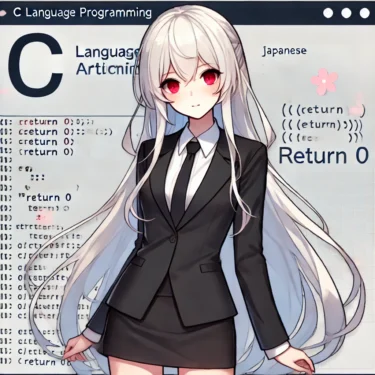- 1 1. What is the goto Statement?
- 2 2. History and Controversy of the goto Statement
- 3 3. Advantages and Disadvantages of the goto Statement
- 4 4. Appropriate Use Cases for the goto Statement
- 5 5. Cases to Avoid goto and Alternative Approaches
- 6 6. Best Practices for Using the goto Statement
- 6.1 Best Practice 1: Use Only When Absolutely Necessary
- 6.2 Best Practice 2: Use for Resource Cleanup or Finalization
- 6.3 Best Practice 3: Use Descriptive Label Names
- 6.4 Best Practice 4: Avoid Overuse
- 6.5 Best Practice 5: Don’t Mix with Complex Control Structures
- 6.6 Best Practice 6: Ensure Code Review for goto Usage
- 6.7 Summary
- 7 7. Conclusion
1. What is the goto Statement?
The goto statement is one of the control structures in C, used to jump to a specified label and manipulate the program’s flow. Unlike many other control structures, the goto statement can jump to almost any location in the program, offering flexibility in controlling execution flow. However, careless use can harm code readability and maintainability, so caution is advised.
Basic Syntax of the goto Statement
The syntax for the goto statement is as follows:
goto label;When a goto statement is executed, program control jumps to the location where the corresponding label is defined. A label is an identifier specified as the jump destination, placed directly before a statement as shown below:
label_name:Let’s look at a simple program to see how the goto statement works in practice.
Example of Using the goto Statement
#include <stdio.h>
int main() {
int i = 0;
start: // Label definition
printf("Value of i: %d\n", i);
i++;
if (i < 5) {
goto start; // Jump to label
}
printf("Loop ended\n");
return 0;
}In this example, the goto statement jumps to the label start and repeats the loop until i reaches 5. While goto can direct execution to any specified label, overusing it can make programs harder to understand. Therefore, it should be used sparingly and with caution.
Use Cases and Caveats for goto
In C, the goto statement may be considered in the following scenarios:
- Error handling: Useful when an error occurs and you want to skip a series of operations to execute resource cleanup.
- Exiting nested loops: Can simplify code when breaking out of deeply nested loops all at once.
However, goto can make code flow more complex and is generally discouraged in large-scale programs. Overuse can lead to “spaghetti code,” which is difficult to maintain. If you choose to use goto, keep readability and maintainability in mind.
2. History and Controversy of the goto Statement
The goto statement is a fundamental control structure that has existed since the early days of programming languages, long before C was developed. However, its use has been the subject of much debate, especially as structured programming became popular. This section explains the history and controversy surrounding goto.
Origins and Early Role of the goto Statement
When programming was in its infancy, the goto statement was one of the few ways to alter the program’s control flow by jumping to another part of the code. Early languages lacked advanced control structures, so goto was frequently used to implement loops and conditional branching. As a result, programs often contained code that jumped between different parts of the file using goto statements.
However, heavy reliance on such jumps led to code that became known as “spaghetti code” — overly complex and hard to understand. This problem prompted the development of clearer control structures like if, for, and while loops, which gradually reduced the use of goto.
Structured Programming and the goto Debate
In the 1970s, renowned computer scientist Edsger Dijkstra famously criticized the goto statement in his essay “Goto Statement Considered Harmful.” His arguments strongly influenced the programming community, encouraging the adoption of structured programming. Dijkstra argued that goto made program control flow harder to follow and should generally be avoided.
Structured programming is a methodology that promotes clear, maintainable code by using control structures such as loops and conditionals instead of arbitrary jumps. As this approach spread, programmers were encouraged to build software without goto wherever possible.
The Role of goto in Modern Programming
Today, goto is discouraged in most programming languages but is still available in some, including C. In certain scenarios — such as error handling — using goto can still be appropriate. However, in most cases, other control structures like if and while are preferred. The debate over whether goto should be used continues, but readability and maintainability should be prioritized.
3. Advantages and Disadvantages of the goto Statement
While goto can offer flexible control flow that is hard to achieve with other structures, it can also reduce readability and maintainability. This section covers its pros and cons with examples.
Advantages of goto
- Simplifies complex error handling — One advantage of
gotois that it can centralize cleanup and error-handling code, particularly in situations with deeply nested conditions.
Example: Allocating multiple resources and freeing them in one place upon error.
#include <stdio.h>
#include <stdlib.h>
int main() {
FILE *file = fopen("example.txt", "r");
if (!file) {
printf("Failed to open file\n");
goto cleanup; // Jump to cleanup on error
}
char *buffer = (char *)malloc(256);
if (!buffer) {
printf("Failed to allocate memory\n");
goto cleanup;
}
// Perform other operations here
cleanup:
if (file) fclose(file);
if (buffer) free(buffer);
printf("Cleanup complete\n");
return 0;
}This example shows how goto allows you to jump to a single cleanup section, reducing code duplication compared to multiple conditional checks.
- Easier exit from nested loops — When breaking out of multiple nested loops at once,
gotocan simplify code compared to multiple flags or checks.
Example: Exiting a double loop immediately when a condition is met.
for (int i = 0; i < 10; i++) {
for (int j = 0; j < 10; j++) {
if (i * j > 30) {
goto exit_loop; // Exit all loops
}
printf("i=%d, j=%d\n", i, j);
}
}
exit_loop:
printf("Loop ended\n");Disadvantages of goto
- Reduced readability — Jumping around the code makes it harder for others to follow the logic, especially in large projects.
- Prone to bugs — Incorrect label placement or missing initialization can cause unexpected behavior.
- Leads to spaghetti code — Overusing
gotocan create tangled, unstructured code that’s difficult to maintain.
Summary
The goto statement can be useful in specific scenarios, but its drawbacks are significant. It’s best to rely on other control structures whenever possible, reserving goto for cases like complex error handling or exiting deep loops.
4. Appropriate Use Cases for the goto Statement
The goto statement, as a control structure, can be useful in specific scenarios. In this section, we’ll explore situations where using goto is appropriate, focusing on error handling and breaking out of nested loops.
Using goto for Error Handling
Since C lacks built-in exception handling structures (such as try-catch), the goto statement is often used to simplify error handling when managing multiple resources. With goto, you can jump to a single section of code dedicated to cleanup, making the logic cleaner and easier to follow.
Example: Error handling when allocating multiple resources.
#include <stdio.h>
#include <stdlib.h>
int main() {
FILE *file1 = NULL;
FILE *file2 = NULL;
char *buffer = NULL;
file1 = fopen("file1.txt", "r");
if (!file1) {
printf("Failed to open file1.txt\n");
goto error; // Jump for error handling
}
file2 = fopen("file2.txt", "r");
if (!file2) {
printf("Failed to open file2.txt\n");
goto error;
}
buffer = (char *)malloc(1024);
if (!buffer) {
printf("Failed to allocate memory\n");
goto error;
}
// Perform operations here
printf("Files and memory operations completed successfully\n");
// Cleanup resources
free(buffer);
fclose(file2);
fclose(file1);
return 0;
error:
if (buffer) free(buffer);
if (file2) fclose(file2);
if (file1) fclose(file1);
printf("Resources released due to error\n");
return -1;
}Here, goto centralizes cleanup when an error occurs, reducing nested conditions and improving readability.
Breaking Out of Nested Loops
In situations with multiple nested loops, goto can be used to break out of all loops immediately once a certain condition is met. Standard break or continue statements only affect the innermost loop.
Example: Breaking out of a double loop when a condition is met.
#include <stdio.h>
int main() {
int i, j;
for (i = 0; i < 10; i++) {
for (j = 0; j < 10; j++) {
if (i * j > 30) {
goto exit_loop; // Exit all loops
}
printf("i = %d, j = %d\n", i, j);
}
}
exit_loop:
printf("Exited loop due to condition\n");
return 0;
}This approach keeps the code concise compared to using multiple flags or conditional checks.
When to Consider Using goto
- Resource cleanup: When multiple resources need to be freed in complex error-handling scenarios.
- Breaking deep loops: When nested loops must be exited immediately once a condition is met.
Cautions When Using goto
While goto can be convenient, it can also reduce readability. Always consider whether the same control flow can be achieved without goto, and limit its use to situations where it truly simplifies the logic.
5. Cases to Avoid goto and Alternative Approaches
Although goto is handy in certain scenarios, overusing it can harm code readability and maintainability. As programs grow more complex, tracking jump targets becomes harder and can lead to bugs. This section covers cases where goto should be avoided and some alternative methods.
Cases Where goto Should Be Avoided
- When readability is critical
Becausegotojumps disrupt the normal flow of code, they can make it harder for others to understand, especially in collaborative projects. - When structured error handling is possible
Many languages support structured exception handling, and in C, similar organization can be achieved through careful function design withoutgoto. - When controlling deep nesting
Usinggotoin deeply nested logic increases the risk of spaghetti code. Instead, consider flags or restructuring logic to reduce nesting.
Alternatives to goto
1. Using Flag Variables
Flag variables can signal when to exit nested loops without goto.
#include <stdio.h>
int main() {
int i, j;
int exit_flag = 0;
for (i = 0; i < 10; i++) {
for (j = 0; j < 10; j++) {
if (i * j > 30) {
exit_flag = 1;
break;
}
printf("i = %d, j = %d\n", i, j);
}
if (exit_flag) break;
}
printf("Loop ended\n");
return 0;
}2. Splitting Functions for Error Handling
Dividing logic into smaller functions can remove the need for goto in error handling.
#include <stdio.h>
#include <stdlib.h>
int read_file(FILE **file, const char *filename) {
*file = fopen(filename, "r");
if (!*file) {
printf("Failed to open %s\n", filename);
return -1;
}
return 0;
}
int allocate_memory(char **buffer, size_t size) {
*buffer = (char *)malloc(size);
if (!*buffer) {
printf("Memory allocation failed\n");
return -1;
}
return 0;
}
int main() {
FILE *file1 = NULL;
char *buffer = NULL;
if (read_file(&file1, "file1.txt") < 0) {
return -1;
}
if (allocate_memory(&buffer, 1024) < 0) {
fclose(file1);
return -1;
}
// Other processing
free(buffer);
fclose(file1);
printf("Processing completed successfully\n");
return 0;
}3. Using break or continue
In some cases, these control statements can replace goto for loop control, especially when the nesting is shallow.
Summary
The goto statement is powerful but should be a last resort. Flags, function splitting, and loop control statements can often achieve the same results while maintaining better readability and maintainability.
6. Best Practices for Using the goto Statement
The goto statement is a powerful and flexible control structure, but improper use can significantly harm code readability and maintainability. This section outlines best practices to follow when using goto, so you can maintain clean and maintainable code while taking advantage of its benefits.
Best Practice 1: Use Only When Absolutely Necessary
Because goto is a strong tool for altering control flow, it should generally be reserved for specific situations such as error handling or breaking out of deeply nested loops. Most programming languages, including C, offer alternative control structures, so consider those first. Use goto only when other methods would make the code unnecessarily complicated.
Best Practice 2: Use for Resource Cleanup or Finalization
In C, memory leaks and unclosed file handles can easily cause bugs. goto can be used to jump to a cleanup section when an error occurs, helping to prevent such issues. Consolidating cleanup logic in one place improves code clarity and reduces the risk of resource mismanagement.
Example: Using goto for resource cleanup
FILE *file = fopen("example.txt", "r");
if (!file) {
goto cleanup; // Jump to cleanup if file fails to open
}
char *buffer = (char *)malloc(1024);
if (!buffer) {
goto cleanup; // Jump to cleanup if memory allocation fails
}
// Other processing...
cleanup:
if (buffer) free(buffer);
if (file) fclose(file);Best Practice 3: Use Descriptive Label Names
Labels indicate jump destinations for goto statements. Avoid vague names — use descriptive ones like cleanup or error to make their purpose clear at a glance.
Best Practice 4: Avoid Overuse
Using goto excessively can quickly turn your code into spaghetti code, making it hard to maintain. Keep usage minimal to avoid unnecessary complexity.
Best Practice 5: Don’t Mix with Complex Control Structures
Combining goto with multiple if, while, and for constructs can make the flow extremely hard to follow. If you must use goto, keep its context simple and isolated from other control structures.
Best Practice 6: Ensure Code Review for goto Usage
When goto appears in your code, have it reviewed by other developers. Code reviews help verify whether goto is truly necessary and if an alternative approach could work better.
Summary
When used correctly and sparingly, goto can help manage control flow effectively, especially in cleanup and error-handling scenarios. However, prioritizing readability and maintainability should always come first. Limit goto usage to clear, well-defined purposes and avoid mixing it with complex logic.
7. Conclusion
This article has explained the C goto statement in detail — from basic usage and historical background to its pros and cons, appropriate use cases, situations to avoid it, alternative approaches, and best practices. While goto is highly flexible and powerful, it requires careful use.
Understand and Use goto with Caution
The goto statement can be effective in specific scenarios, such as error handling and breaking out of deeply nested loops. However, overuse can negatively impact code readability and maintainability. When other control structures are available, they are generally preferred. If you do use goto, choose clear label names and limit its usage to targeted purposes like cleanup.
Follow Best Practices for Effective Use
As outlined in this article, the best way to use goto is to keep its scope minimal, apply it mainly for resource cleanup or error handling, and name labels descriptively. By following these principles, you can take advantage of goto’s strengths while keeping your code maintainable and easy for others to understand.
Final Summary
Although the C goto statement may seem simple, using it effectively requires a solid understanding of its behavior. To write robust and maintainable code, avoid mixing goto with other control structures unnecessarily, evaluate whether it’s truly needed, and consider alternative approaches first. When used with discipline, goto can be a helpful tool in your C programming toolkit.




